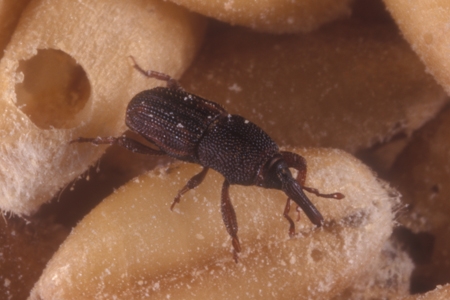Active Seasons




Rice Weevil Appearance and Size Facts
Rice weevils get their name from—you guessed it—the stored grains they use to sustain themselves, including rice, seeds, wheat, cereals, and more. These are beetles infamous for posing a significant threat to agricultural yields and stored grain quality, making them a serious problem in many places around the globe.
Here are some key details about rice weevils:
- Dark, reddish brown with patches. Rice weevils often have four light-colored patches on their wings.
- Approximately one-eighth of an inch long. These are very small pests—smaller than a grain of rice!
- Prolonged, pointy head. You can spot rice weevils by their long body and distinctive narrow snout.
- Antennae. Rice weevils’ antennae are noticeably pointy and curvy.
Distinguishing Rice Weevils From Other Beetles
If you’re wondering how to tell the difference between rice weevils and other beetles, there are a few things to look for. First and foremost, weevils typically have a much narrower snout, called a rostrum, and overall body structure. Additionally, rice weevils usually can be identified by their four light patches on their wing covers and their densely pitted thorax.
We offer pest control for rice weevils in the following locations and their surrounding areas:

Behavior and Habitat of Rice Weevils
Rice weevils are internal feeders, meaning they feed within the grain. The female uses her strong jaw bones to gnaw a small hole in a grain kernel and then deposits a single egg inside before closing it off. The egg then matures and nourishes itself inside before exiting and finding a mate to reproduce.

Signs of Infestation of Rice Weevils
The most obvious sign of a granary or rice weevil infestation is the presence of adult weevils, which are small beetles with noticeably long snouts. These pests lay eggs inside grains, leading to the appearance of tiny holes as they rapidly reproduce. Other signs include clumped or damaged grains, a musty odor, and the presence of dust or powder at the bottom of the storage container. Rice weevils thrive in undisturbed grain storage areas, making it essential to routinely inspect your stored grains to prevent significant damage.

Tips for Prevention of Rice Weevils
The first step in rice weevil prevention is to ensure that any newly purchased rice or grains are free from infestation. This can be achieved by buying from reputable suppliers and visually inspecting the grains. Use airtight containers made of glass, metal, or heavy-duty plastic to store grains, and clean storage areas regularly. Additionally, avoid mixing old and new batches of grains, as this can spread an infestation. You should also regularly rotate your stocks and conduct periodic checks for signs of weevils, such as damaged grains or the presence of adult beetles.
Getting Rid of Rice Weevils
If you’re wondering how to get rid of rice weevils, you must remember that thoroughness is key. Begin by securely discarding any infested rice or grains immediately, then thoroughly vacuum the storage area (including any crevices) to get rid of weevils, larvae, and eggs. After that, wash the storage areas with soapy water to eliminate any potential residue. Before restocking grains, ensure the area is dry and sanitized. While following these tips is essential, your best bet to eliminate rice weevils is to invest in residential pest control or commercial pest control services.
Effective Rice Weevil Control Solutions
Finding an infestation of rice weevils is no doubt stressful, but you’re not alone. Call in the pros at Hulett Environmental Services for expert weevil control services in Florida. With more than 50 years of experience under our belt, we’ve earned a reputation for providing the best pest control in south Florida. Our friendly team of technicians has the tools and experience necessary to effectively eliminate issues with rice weevils and many other common household pests.
Are you ready to take the next steps toward creating a pest-free home? Schedule a free inspection or give us a call with any questions about weevil control in south Florida today!




